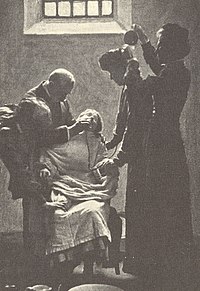
Photo from wikipedia
Abstract A dose‐response experiment was conducted to investigate the effects of excess DL‐methionine (DLM) and L‐methionine (LM) on growth response of starter Pekin ducks from 7 to 21 days of… Click to show full abstract
Abstract A dose‐response experiment was conducted to investigate the effects of excess DL‐methionine (DLM) and L‐methionine (LM) on growth response of starter Pekin ducks from 7 to 21 days of age. A total of 462 seven‐day‐old male Pekin ducklings were allotted to 77 wire‐floor pens with 6 birds per pen. There were 11 treatments including a methionine‐adequate control diet (containing 0.49% methionine) and control diets supplemented with 5 levels of crystal DLM or LM (0.25, 0.50, 0.75, 1.0, and 1.25%) based on equal product weight. At 21 d of age, weight gain, feed intake, and feed/gain of ducks from each pen were measured. In our study, the weight gain and feed intake did not change markedly and kept a plateau when supplemental DLM or LM was below 0.50%, but the weight gain and feed intake decreased further as supplemental DLM or LM increased from 0.50 to 1.25%. When the maximum safe level (MSL) of supplemental methionine sources and methionine content of the control diets were combined, the total tolerable upper limits of methionine for weight gain and feed intake were 0.91 and 0.85% when DLM was used, respectively, and the corresponding values were 0.89 and 0.84% when LM was used, respectively. On the other hand, both excess DLM and LM reduced weight gain and feed intake (P < 0.05) but there were no significant differences (P > 0.05) in weight gain and feed intake between the ducks fed DLM‐ and LM‐supplemented diets. Furthermore, linear slope‐ratio assay was also used to evaluate the relative toxicity of excess DLM and LM. According to this assay, the efficiencies of DLM relative to LM for depression of weight gain and feed intake were 97 and 95%, respectively. In summary, excess DL‐ and L‐methionine were toxic for starter Pekin ducks and both methionine sources were equally growth depressing.
Journal Title: Poultry Science
Year Published: 2018
Link to full text (if available)
Share on Social Media: Sign Up to like & get
recommendations!